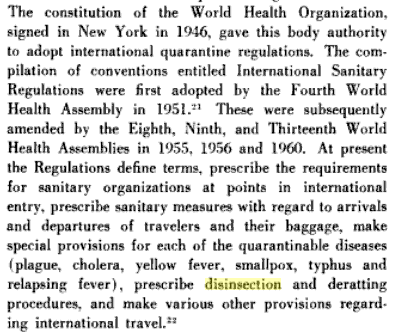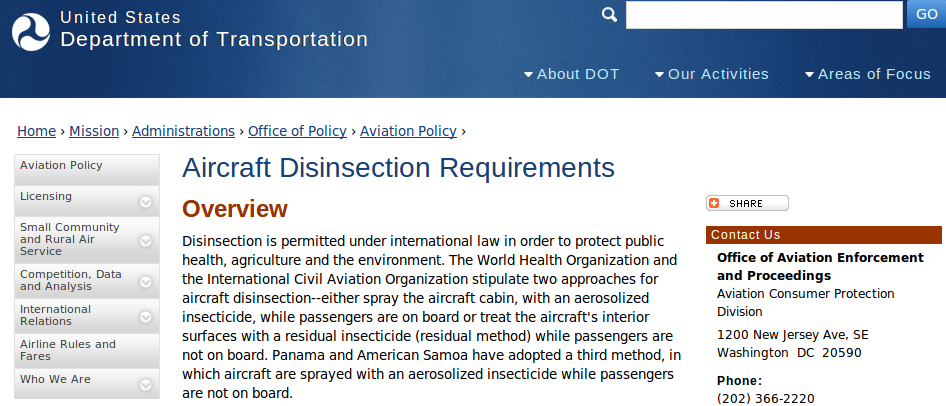Disinsectioning
« previous post | next post »
I'm about to leave for Hong Kong, and the travel agency that arranged my tickets sent me an email with reservation details that contained various other helpful notes, including this one:
DOT Announcement Regarding Aircraft Disinsection
At first I read this note as dealing with "disinfection". Then I noticed that it actually reads disinSection, and thought, that's an odd typo. So I followed the link and discovered that they really do mean disinsection, a word that I didn't know:
The Oxford English Dictionary doesn't know about disinsection either. Wordnik says "Sorry, no definitions found", but does turn up some illustrative examples. Merriam-Webster's online dictionary knows about disinsectization "removal of insects (as from an aircraft)", and does have an entry for disinsection, defined as "disinsectization".
No one seems to use insection to mean "infestation by insects". The OED glosses insection as "The action of cutting into, incision; division into sections; concr. an incision, division, indentation", or as "a declaration, treatise, or long continued talk" (flagged as Obs. rare). M-W defines it as "a notched or segmented part <insections of a leaf margin>". Wordnik tells us that the Century Dictionary and Cyclopedia defined insection as "A cutting up; division into segments; also, a segment or section", while Webster's 1913 had "A cutting in; incisure; incision".
So I hope to continue relatively uninsectioned, as well as disinsectioned.
I've certainly experienced the process (of "spray[ing] the aircraft cabin, with an aerosolized insecticide"), but this is the first time that I've seen the word disinsection. This word has nevertheless been around for a while: thus Tropical health: a report on a study of needs and resources (1962) explains that

I note that while WHO believes that killing insects in aircraft is "disinsection", they call killing or removal of rats "deratting" rather than "disration" (or perhaps "disratization"). Even productive English morphology is quasi-regular.

bulbul said,
December 2, 2012 @ 7:29 am
That's funny. Around here, we commonly use "dezinfekcia", "dezinsekcia" and "deratizácia" and I've always assumed we got them from French (désinfection, désinsection*, dératisation). Is it possible "deratting" was contaminated by the French term?
* In current French désinsectisation seems to be the preferred term, at least judging by EURLEX, with désinsection possibly being obscolescent.
Morpho hecuba said,
December 2, 2012 @ 7:41 am
This is actually about fighting insecting insects: giant leafcutter ants that leave insections in airplanes. It is speculated that they take the airplane for another insect and cut holes in its abdomen to lay their eggs in it.
Sili said,
December 2, 2012 @ 8:21 am
Pity we've dropped the long ſ.
@oulenz said,
December 2, 2012 @ 8:34 am
I would have expected disinsectation.
Jarek Weckwerth said,
December 2, 2012 @ 9:01 am
I second bulbul. Polish seems to work the same way as Slovak, with dezynfekcja, dezynsekcja and deratyzacja. Funny, the latter two must be quite opaque for a speaker of Polish with no knowledge of French or English.
ajay said,
December 2, 2012 @ 9:49 am
I note that while WHO believes that killing insects in aircraft is "disinsection", they call killing or removal of rats "deratting" rather than "disration" (or perhaps "disratization")
I suppose "debugging" was already taken.
Ray Dillinger said,
December 2, 2012 @ 11:54 am
Actually a very small number of insect pests are actually "bugs". (http://en.wikipedia.org/wiki/Hemiptera) We use the word "bug" in casual speech for any insect, of course, (and sometimes extend it to arthropods in general) but this is a construction describing a legally required procedure, and legalese is based almost exclusively on formal definitions.
In other contexts, a coinage based on an informal definition is plausible and you might call an insects-must-be-dead-to-fly policy "debugging" — but if so I doubt the term would ever make the transition to legalese; it would have to be "debugged" first.
Michael Watts said,
December 2, 2012 @ 12:31 pm
Some thoughts on the word come to mind for me:
"Disinsection" is totally opaque. But I can understand "disinsectization" as a construction from parts.
If I were trying to construct such a word myself, I would be vastly more likely to use the prefix "de-" rather than "dis-". The first thing to come to mind is "de-insectify".
Q. Pheevr said,
December 2, 2012 @ 12:49 pm
Or maybe deratization? The OED has an entry for that one, in which the first illustrative quotation is from a 1914 item in Notes & Queries, quoting The Standard on the appearance of the word in a Board of Trade translation of a document issued by the Cuban Quarantine Department:
(So perhaps deratization is an English calque of desratización?) In any case, I thought it was neat to find the OED citing a source so similar to this very blog post—a "gee, I've never seen that word before" note—from nearly a century ago.
Victor Mair said,
December 2, 2012 @ 1:00 pm
I distinctly remember one flight to or from East Asia when the stewards and stewardesses walked through the cabin handing out pieces of paper on which were printed "Aircraft Disinfection Requirements". The language was identical to the Department of Transportation "Aircraft Disinsection Requirements" in the screenshot above. Naturally, I was quite alarmed and asked the stewards and stewardesses if this meant they were going to spray the plane with some sort of fumigant. They told me that this is exactly what they were going to do. Whereupon several of them marched through the cabin and began spraying large amounts of fumigant. I could not believe this was happening and though that we were all going to die, or at least that the length of our lives would be reduced by some months. Unfortunately, because I fly to Asia so often, I can't remember which airline I was flying on that time, but I do recall quite clearly that the "requirements" printed on the piece of paper that was handed out to all the passengers on the plane were the same as the Department of Transportation "Aircraft Disinsection Requirements".
Since the language of these "Aircraft Disinfection Requirements" was identical to the Department of Transportation "Aircraft Disinsection Requirements", someone in the airline administration must have changed "Disinsection" to "Disinfection", with or without the prompting of a spell-checker. In fact, when I just now did a Google search on "Aircraft Disinfection Requirements", I scored nearly two dozen hits, most — but not all — of which were copying from and intending to present the Department of Transportation "Aircraft Disinsection Requirements".
Dick Margulis said,
December 2, 2012 @ 3:00 pm
I never encountered the procedure until two weeks ago, flying from Guayaquil to Baltra (Galapagos). There was no written announcement. There was only a recorded announcement in Spanish and then English that the cabin crew would soon spray the cabin with an insecticide to ensure that no alien insect species be introduced to the islands and reassuring us that the spray was not harmful to us humans (I can't say I felt reassured on that count, but then the crew are exposed to the stuff daily, so how bad can it be?). Immediately, two crew members marched down the aisle methodically opening each overhead luggage compartment and dousing it with an aerosol. On the one hand, maybe it did shorten my life by a few minutes. On the other hand, I got to go to the Galapagos. Seems like a fair tradeoff. In any case the word disinsection was not uttered.
Sam said,
December 2, 2012 @ 3:18 pm
The earliest appearance on Google Books appears to be from 1949; it is interesting (but probably just an artifact of Google's incomplete coverage) that this predates the earliest appearance of the verb "disinsect" by three years.
Andy Averill said,
December 2, 2012 @ 3:50 pm
Checking Google Books, there appears to have been a short-lived vogue for the word disinsection in military contexts around the time of WWI, referring to delousing of soldiers or clothing. Nothing after that till a 1961 paper by D.F. Maddock, V.A. Sedlach and H.F. Schoof, Preliminary tests with DDVP vapour for aircraft disinsection.
Incidentally DDVP seems to have been developed especially for aircraft fumigation. Mother Jones printed an expose of the practice in 1998, but it hasn't been banned as yet. Probably because nearly everybody agrees that insect infestations on planes are much more dangerous than side effects to passengers (roaches chewing through electrical insulation and causing short circuits, that kind of thing).
Today disinsection seems to be used almost exclusively in an aviation context, although it occasionally shows up in discussions of ship fumigation and grain storage.
Andy Averill said,
December 2, 2012 @ 3:54 pm
@Sam, our posts seem to have crossed, but way at the end of the Google Books results there's a couple from 1918-1921. Along with numerous OCR misreadings of "disinfection", as one expects with Google Books.
Andy Averill said,
December 2, 2012 @ 3:58 pm
@Dick Margulis, there doesn't seem to be a Spanish equivalent — I found a Spanish-English technical dictionary where disinsection was translated "Eliminación de los insectos de un área."
Thor said,
December 2, 2012 @ 5:07 pm
A quick search on the UN Specialized Agency International Civil Aviation Organization (ICAO) Web site gives 58 hits.
AntC said,
December 2, 2012 @ 10:51 pm
"spraying large amounts of fumigant", as Victor describes, I well remember flying to New Zealand in the '80s and early '90s.
This was not (@Andy) because of a fear of damage to the aircraft, but to prevent pests devastating agriculture. The practice is no more. Now our bees have Varroa mite, our Kiwi fruit have PSA virus, there's a constant battle against fruit fly in Auckland, …
(Of course, there is no evidence these pests arrived through air passengers.)
Andy Averill said,
December 3, 2012 @ 12:49 am
@AntC, I'm sure you're right that stopping the spread of insect pests is one of the reasons it's done. But wouldn't New Zealand be kind of a special case? I would imagine most other countries have been exposed to every imaginable pest a long time ago.
Jarek Weckwerth said,
December 3, 2012 @ 2:37 pm
I saw the spraying procedure on a flight from India to Qatar and understood that it was mainly targeted at mosquitoes (think malaria etc.). What worried me was not so much the spray but the fact that a number of the things remained happily flying at least until the lights were dimmed.
erik i said,
December 3, 2012 @ 4:09 pm
I wonder if they are deliberately using a strange word in this context because they don't want the passengers imagining that there might be a bunch of insects living in the plane.
chris said,
December 3, 2012 @ 5:54 pm
Actually a very small number of insect pests are actually "bugs".
True, but I doubt if the disinsection procedure is really intended to leave all the spiders and scorpions in peace, so its name is probably imprecise already.
John said,
December 3, 2012 @ 8:41 pm
@ Jarek Weckwerth: The same regime applies in Saudi Arabia, particularly during Haj. Planes coming in from areas where particular diseases are prevalent or where mosquito-borne diseases thrive get the treatment.